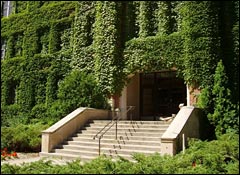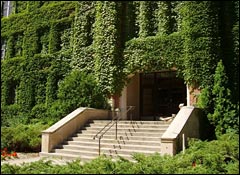The dawn of the new school year has brought with it a corps of fresh-faced ideas and initiatives aimed at making colleges and universities cleaner and greener. And, like any freshman class, they are all beaming with potential: Most will succeed, a handful will excel, and a few will end up disappointing their parents.

Campuses are going green — and not just with ivy.
Photo: iStockphoto
The greening of academe is nothing new, but it seems to have taken root in a big way. Today, it’s not just about doing a few good, green things — recycling, buying green energy, building green buildings, and all the rest — and it’s not just about saving money or being seen as a good neighbor. It’s about being seen as a sustainability leader in order to attract students, funding, and media attention.
As a result, in a growing number of schools, “green” has become the Big Meme on Campus.
But getting colleges and universities to make the grade as environmental leaders is no slam dunk. Like their corporate counterparts, schools face a variety of challenges and barriers, from a lack of top-level commitment, to institutional inertia, to a dearth of answers to the seemingly simple question “How good is ‘good enough’?”
Companies and activist groups alike are trying to help schools answer that question. For example, General Electric and mtvU recently launched an ecomagination Challenge, with a $25,000 prize for the school proposing “the most impactful and innovative project to ‘green’ their campus.” It joins the Campus Climate Challenge, an activist-led network of more than 300 schools promoting leadership on global warming.
So, how do you green a school? When viewed through a green lens, colleges and universities are, in fact, businesses. A decent-sized school can combine the environmental footprint of a myriad of operations: office buildings, hotels, food service, laundry, retail, vehicle repair and maintenance, energy production, waste hauling, construction, health care, even road building and small manufacturing. And if there is scientific research going on, it may involve a witch’s brew of hazardous chemicals and materials, from urethane to uranium.
Forget a business. A college is actually more like a small city.
A Matter of Policy
So, how do we make all that activity safe for people and the planet? First, someone’s got to take the lead. At some schools that leadership comes from the administration and faculty. At others, it comes from the real powers that be: the students themselves.
Historically, students have been the major drivers, says Julian Dautremont-Smith, associate director of the Association for the Advancement of Sustainability in Higher Education. “They can make things happen in a way that staff or faculty haven’t. That said, there is increasingly leadership from school presidents that are committed to these issues. It’s developed into a more high-level activity. Schools are trying to compete — be the leader in environmental studies or sustainability.”
Inevitably, though, it takes a village. For example, at the University of California campuses, students have proposed dozens of policies that have been embraced by administrators, from green building designs to organic produce in the dining halls. Student representatives from throughout the UC system created the California Student Sustainability Coalition “to fight for a sustainable University of California,” according to the group’s website. Activist groups have played a role. A campaign sponsored by Greenpeace targeted system-wide policy changes to bring green buildings and renewable energy to all UC campuses. (Full disclosure: My firm, Clean Edge, authored a report funded by Greenpeace as part of that campaign.)
The UC administration has pitched in, too. The university system’s governing body, the UC Regents, approved a Green Building Policy and Clean Energy Standard [PDF] in 2003, which mandates that new buildings outperform state energy-efficiency requirements by at least 20 percent. And in the UC’s Office of the President, there sits a “sustainability specialist.”
Sustaining and broadening campus greening initiatives over time has proven to be very difficult for most students, who typically cycle in and out of the campus every two to four years, says Julian Keniry, who heads the National Wildlife Federation’s Campus Ecology Program. “We’ve encouraged addressing this in three ways: cultivating administrative champions who can adopt and build programs over time, hiring sustainability directors to lead and facilitate these initiatives, and developing alumni networks to serve as fiscal sponsors and watchdogs,” she says, adding that there has been good progress on the first two: “Administrative champions are emerging who are networking through their planning, business, and physical-plant associations, and dozens of colleges and universities have created a sustainability director or similar positions.”
Fee to Be You and Me
How to pay for green investments, like solar panels or green building designs, is another matter. Cash-strapped school administrators may balk at spending extra money for such things, even if the investments will yield savings within a few years. Students inevitably end up paying the extra costs, either through tuition hikes or voluntary fees. For example, in July, the Tennessee Board of Regents approved increases in student fees to fund renewable energy at Middle Tennessee State University and Tennessee Technological University. The $8-per-semester fee hikes had previously been approved by almost 90 percent of students at both institutions. Students at Central Oregon Community College voted last spring to increase their $1.75-per-credit hour student fee by 25 cents in order to purchase renewable energy.
It can be money well spent, and not just for the environment. The process of greening campuses can provide a learning opportunity for students that will be directly transferable to greening their future employers, says Liz Maw, executive director of Net Impact, the 10,000-member association of MBA students and recent grads, which runs a Campus Greening Initiative. “Students build project-management skills, cost-benefit analytical skills, change-management skills, and communication skills,” she says.
Ultimately, the real challenge is determining how much is “enough.” There is no certification program or generally accepted definition of a “green campus,” leaving each campus to define its own goals. As with companies, this leads to some schools hyping what amounts to a so-so greening effort — the equivalent of a C student acing a single course and claiming to be a scholar. “There are some schools not doing as much as they could do and claiming to be leaders,” acknowledges Dautremont-Smith. “But some are putting sustainability into their guiding documents — their mission statement, master plan, and strategic plan.” That, he says, is the sign of a true leader.
Tools Rush In
Despite the lack of standards, there are several tools to assess sustainability on campus. The most comprehensive is the Campus Sustainability Assessment Framework, the result of more than two years of intensive work by a master’s student at Royal Roads University in British Columbia. It covers 170 social, environmental, cultural, political, and economic indicators to assess campus sustainability, including short-term and long-term goals for many indicators. Schools all over Canada are using it to support sustainability progress, says Dautremont-Smith.
That’s a long list, to be sure. Others have come up with simpler checklists — see here and here, for example. However “simpler,” they still describe the full range of potential activities in which a comprehensive sustainability effort needs to engage.
It’s a lot of work, to be sure. It requires tilting against windmills (or maybe installing them), enlightening and inspiring leaders, and getting bureaucracies to change their well-worn habits.
At minimum, it’s good practice for what students will face after graduation.
Green Campus 101
Worldwatch Institute offers several case studies on campus greening initiatives. Good resources can also be found on the websites of NWF’s Campus Ecology Program and the Association of University Leaders for a Sustainable Future.


